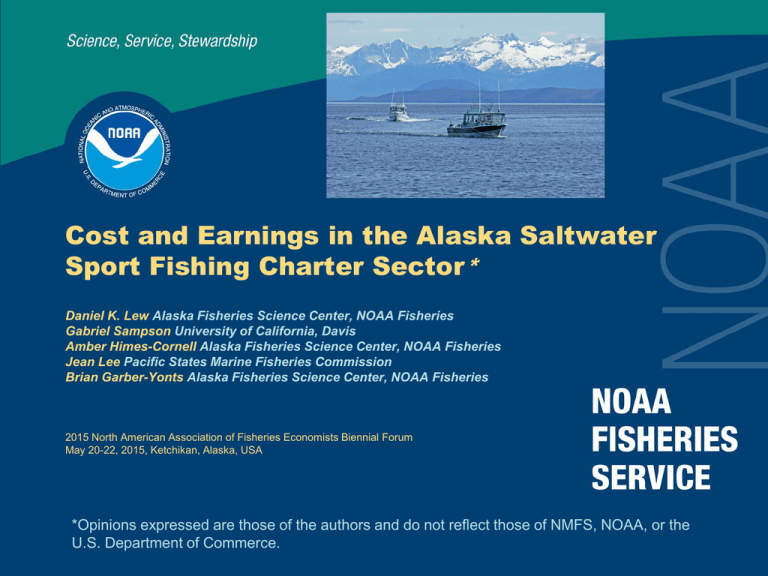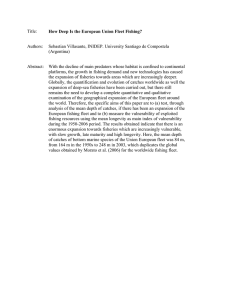Cost and Earnings in the Alaska Saltwater Sport Fishing Charter Sector *
advertisement

Cost and Earnings in the Alaska Saltwater Sport Fishing Charter Sector* Daniel K. Lew Alaska Fisheries Science Center, NOAA Fisheries Gabriel Sampson University of California, Davis Amber Himes-Cornell Alaska Fisheries Science Center, NOAA Fisheries Jean Lee Pacific States Marine Fisheries Commission Brian Garber-Yonts Alaska Fisheries Science Center, NOAA Fisheries 2015 North American Association of Fisheries Economists Biennial Forum May 20-22, 2015, Ketchikan, Alaska, USA *Opinions expressed are those of the authors and do not reflect those of NMFS, NOAA, or the U.S. Department of Commerce. Pacific halibut fisheries off Alaska Two main IPHC regulatory areas where both guided and unguided Pacific halibut sport fishing occur Area 2C (Southeast Alaska) Area 3A (Southcentral Alaska) Important Issues • Declining stocks over the last decade • Until 2014, allocation was determined using a guideline harvest level policy • Guided (charter) sector has grown substantially (until recent years) • Halibut IFQ program excludes non-commercial and non-CDQ entities, thereby precluding the flow of IFQ across sectors • Catch Sharing Plan (CSP) implemented in 2014 • Sets formula for commercial/recreational allocation depending on stock • Allows leasing of IFQ from commercial sector to charter sector 2 Project goals • Collect baseline economic data from charter businesses • Generate population-level estimates (total revenues, total costs, employment, etc.) • Fishery/state-level (here) • Fishing community and regional level (in progress) • Use sample weighting and data imputation approaches to adjust for missing data • Methodologies described in Lew, Himes-Cornell, and Lee (2015, Marine Resource Economics) • Identify/assess trends in costs, revenues, employment in 20112013 fishing seasons • Details in NOAA tech memo (Lew, Sampson, Himes-Cornell, Lee, and Garber-Yonts 2015) 3 Alaska Saltwater Sport Fishing Charter Business Survey • 12 page survey that collects data from Alaska charter businesses offering sport fishing trips to angler clients in Alaska • Target population: All active charter businesses in Alaska • Data collected include: employment, services offered, revenues, costs, types of clients • Administered as a population census in 2012-2014 as a repeat mail survey (using a modified Dillman approach including a telephone prompt) Fishing Year 2011 2012 2013 Population Size Unit Responses 650 174 592 141 572 125 Response Rate 27% 24% 22% 4 Missing data • Missing data comes in two forms • • Unit non-response: sampled individuals or entities (i.e., the targeted respondents contacted to participate) that do not respond to any component of the survey Item non-response: refers to cases where individual questions in the survey are left unanswered • Voluntary social and economic surveys in fisheries contexts often have missing data • Missing data may introduce biases in survey estimates if unaddressed • Weighting and data imputation are used to adjust sample data for missing data 5 Sample weighting Individual weight for individual i (wi), ∀i in n (Brick and Kalton): wi = w1i × w2i × w3i where w1 = sample selection weight (“base” weight) inverse of the probability of being selected for sample (e.g., N/Npop for simple random sample) w2 = non-response adjustment weight adjusts for difference in those who respond and those who do not w3 = post-stratification weight ensures that the sample conforms to a known population characteristic (reduces coverage error) 6 Non-response adjustment and post-stratification weights • Non-response weight (w2) • • • Used logit model to identify differences between respondents and non-respondents based on 17 variables from charter logbook records Weighting classes: divide respondents and non-respondents on small number of characteristics (respondents given weights equal to inverse of frequency within each cell) Post-stratification weights (w3) • Weights were based on both effort (as measured by total client trips) and IPHC area 2011 Variable No late shoulder or off-season fishing No late shoulder fishing but some off-season fishing Some late shoulder fishing but no off-season fishing Both late shoulder and off-season fishing Percent of 2011 weight responding (w2) sample (%) 1.3248 15.52 2.2996 0.57 0.9808 0.527 74.71 9.2 2012 Variable Did not fish for salmon Fished for salmon Percent of 2012 weight responding sample (%) (w2) 0.6562 14.08 1.0588 85.92 2013 Variable No late season fishing Late season fishing Percent of 2013 weight responding sample (%) (w2) 1.8837 10.32 0.8983 89.68 7 Data imputation: K-nearest neighbor imputation • Distance function is used to determine the most similar item respondent to each item non-respondent. • Charter logbook data provided the auxiliary information • Eight variables related to where, how much, and when fishing was done, as well as the types of fishing, such as target species • Missing values are randomly selected from among the K=3 nearest neighbors 8 Population totals and variances • Totals for costs, revenues, and employment are calculated by weighted summation over constituent categories after the missing data have been imputed • Variances are calculated using the simulation approach of Shao (2002) that accounts for the variance associated with the data imputation method 9 Labor population estimates, 2011-2013 Guides Crew Number of Positions Number of Positions 1200 1000 800 600 400 200 0 Early Shoulder Main Season 2011 2012 Late Shoulder Off Season 2013 900 800 700 600 500 400 300 200 100 0 Early Shoulder 2011 Main Season 2012 Late Shoulder Off Season 2013 Number of Positions Shore workers 2000 1500 1000 500 0 Early Shoulder 2011 Main Season 2012 Late Shoulder Off Season Notes: • Population of charter businesses fell between 2011-2013 (650 to 572) • Full and part-time workers aggregated • Most year-to-year changes occurred in main fishing season (Memorial Day to Labor Day) 2013 10 Estimated mean costs by type 11 Mean total revenues and costs 12 Population-level total revenue and cost estimates 13 Discussion • Labor • Some shifts to more full-time employment for shore and crew workers, decline in number of shore workers • Total number of guides were fairly constant across years despite a shrinking fleet • Revenues and Costs • Revenues were higher in 2013 compared to 2011 • Except for investment expenses, average per business costs were lower in 2013 than in 2011 • Implications • Charter sector operated at a loss during 2011, but then became profitable in 2012-2013 14 Next Steps • Fishing community-level analysis (in progress) • Apply weighting and data imputation to generate fishing community-level estimates • Did recreational charter fishing change in the years leading up the CSP in fishing communities? • Contributions analysis (state and regional levels) • Generate estimates of total output, spending, and employment • Post-CSP survey • Will be conducted in 2016 and 2017 • Individual firm-level modeling: profit functions and entry-exit decisions to measure effects of allocation and/or regulations 15



